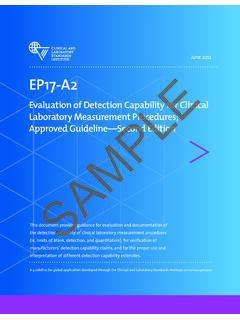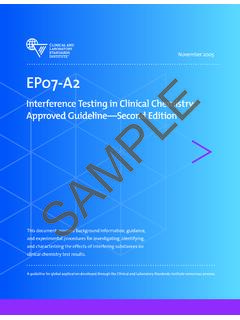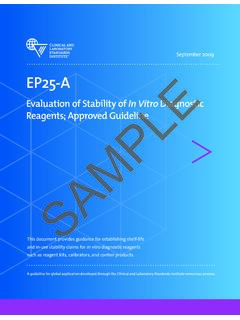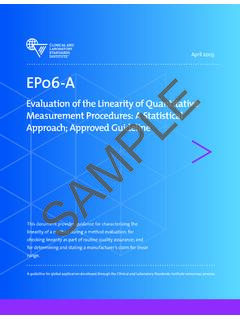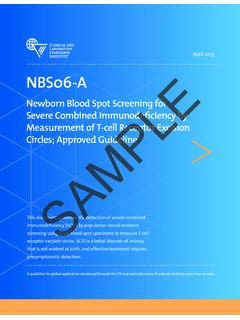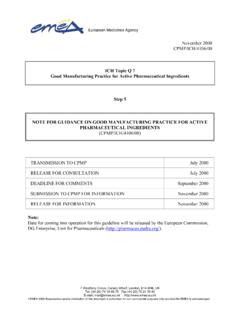Transcription of EP12-A2: User Protocol for Evaluation of Qualitative Test ...
1 January 2008EP12-A2 User Protocol for Evaluation of Qualitative Test Performance; Approved Guideline Second EditionThis document provides a consistent approach for Protocol design and data analysis when evaluating Qualitative diagnostic tests. Guidance is provided for both precision and method-comparison guideline for global application developed through the Clinical and Laboratory Standards Institute consensus process. SAMPLEC linical and Laboratory Standards InstituteSetting the standard for quality in clinical laboratory testing around the Clinical and Laboratory Standards Institute (CLSI) is a not-for-profit membership organization that brings together the varied perspectives and expertise of the worldwide laboratory community for the advancement of a common cause: to foster excellence in laboratory medicine by developing and implementing clinical laboratory standards and guidelines that help laboratories fulfill their responsibilities with efficiency, effectiveness, and global applicability.
2 Consensus ProcessConsensus the substantial agreement by materially affected, competent, and interested parties is core to the development of all CLSI documents. It does not always connote unanimous agreement, but does mean that the participants in the development of a consensus document have considered and resolved all relevant objections and accept the resulting agreement. Commenting on DocumentsCLSI documents undergo periodic Evaluation and modification to keep pace with advancements in technologies, procedures, methods, and protocols affecting the laboratory or health s consensus process depends on experts who volunteer to serve as contributing authors and/or as participants in the reviewing and commenting process. At the end of each comment period, the committee that developed the document is obligated to review all comments, respond in writing to all substantive comments, and revise the draft document as appropriate. Comments on published CLSI documents are equally essential, and may be submitted by anyone, at any time, on any document.
3 All comments are addressed according to the consensus process by a committee of experts. Appeals ProcessIf it is believed that an objection has not been adequately addressed, the process for appeals is documented in the CLSI Administrative comments and responses submitted on draft and published documents are retained on file at CLSI and are available upon request. Get Involved Volunteer! Do you use CLSI documents in your workplace? Do you see room for improvement? Would you like to get involved in the revision process? Or maybe you see a need to develop a new document for an emerging technology? CLSI wants to hear from you. We are always looking for volunteers. By donating your time and talents to improve the standards that affect your own work, you will play an active role in improving public health across the further information on committee participation or to submit comments, contact and Laboratory Standards Institute950 West Valley Road, Suite 2500 Wayne, PA 19087 USA P: : EP12-A2 Vol.
4 28 No. 3 ISBN 1-56238-654-9 Replaces EP12-AISSN 0273-3099 Vol. 22 No. 14 User Protocol for Evaluation of Qualitative Test Performance; Approved Guideline Second Edition Volume 28 Number 3 Patricia E. Garrett, PhD Fred D. Lasky, PhD Kristen L. Meier, PhD Abstract Clinical and Laboratory Standards Institute document EP12-A2 User Protocol for Evaluation of Qualitative Test Performance; Approved Guideline Second Edition provides the user with a consistent approach for Protocol design and data analysis when evaluating Qualitative diagnostic tests. Guidance is provided for both precision and method-comparison studies. Clinical and Laboratory Standards Institute (CLSI). User Protocol for Evaluation of Qualitative Test Performance; Approved Guideline Second Edition. CLSI document EP12-A2 (ISBN 1-56238-654-9).
5 Clinical and Laboratory Standards Institute, 950 West Valley Road, Suite 2500, Wayne, Pennsylvania 19087 USA, 2008. The Clinical and Laboratory Standards Institute consensus process, which is the mechanism for moving a document through two or more levels of review by the health care community, is an ongoing process. Users should expect revised editions of any given document. Because rapid changes in technology may affect the procedures, methods, and protocols in a standard or guideline, users should replace outdated editions with the current editions of CLSI documents. Current editions are listed in the CLSI catalog and posted on our website at If your organization is not a member and would like to become one, and to request a copy of the catalog, contact us at: Telephone: ; Fax: ; E-Mail: Website: SAMPLEN umber 3 EP12-A2 iiCopyright 2008 Clinical and Laboratory Standards Institute.
6 Except as stated below, any reproduction of content from a CLSI copyrighted standard, guideline, companion product, or other material requires express written consent from CLSI. All rights reserved. Interested parties may send permission requests to CLSI hereby grants permission to each individual member or purchaser to make a single reproduction of this publication for use in its laboratory procedure manual at a single site. To request permission to use this publication in any other manner, e-mail Suggested Citation CLSI. User Protocol for Evaluation of Qualitative Test Performance; Approved Guideline Second Edition. CLSI document EP12-A2. Wayne, PA: Clinical and Laboratory Standards Institute; 2008. Proposed Guideline July 2000 Approved Guideline August 2002 Approved Guideline Second Edition January 2008 ISBN 1-56238-654-9 ISSN 0273-3099 SAMPLEV olume 28 EP12-A2 vContents Abstract .. i Committee Membership.
7 Iii Foreword .. vii Laboratory Error Sources and CLSI Evaluation Protocols Documents .. ix 1 Scope .. 1 2 Introduction .. 1 3 Standard Precautions .. 2 4 Clinical Utility .. 2 Screening Tests .. 3 Diagnostic Tests .. 3 Confirmatory Tests .. 3 5 Terminology .. 3 A Note on Terminology .. 3 Terms for Comparative Benchmark .. 4 Definitions .. 5 6 Device Familiarization and Training .. 8 Purpose .. 8 Duration .. 8 7 Evaluation Materials .. 8 Controls .. 8 Specimen Collection and Handling .. 8 8 Bias and Imprecision Studies .. 8 Analyte Concentrations Near the Cutoff .. 9 Negative and Positive Controls .. 11 A Qualitative Method-Precision Experiment for Analyte Concentrations Near the C50 .. 12 9 Comparison of Methods .. 14 Test Specimens .. 15 Number of Specimens .. 16 Duration .. 16 Inspection of Data During Collection .. 16 Discrepant Results .. 16 Reference Specimen Panels .. 17 10 Data Analysis .. 17 Comparator Is Diagnostic Accuracy Criteria.
8 17 Comparator Other Than Diagnostic Accuracy Criteria .. 23 Examples .. 25 References .. 32 Appendix. Statistical Reasoning for Precision Experiment Conclusions .. 34 Summary of Consensus Comments and Working Group Responses .. 40 SAMPLEN umber 3 EP12-A2 viContents (Continued) Summary of Delegate Comments and Working Group Responses .. 41 The Quality Management System Approach .. 44 Evaluation Protocols Documents, Descriptions, and Key Words .. 45 SAMPLEV olume 28 EP12-A2 Clinical and Laboratory Standards Institute. All rights reserved. 1 User Protocol for Evaluation of Qualitative Test Performance; Approved Guideline Second Edition 1 Scope This guideline provides protocols for the Evaluation of Qualitative test performance characteristics. In this document, a Qualitative test is restricted to those tests that have only two possible outcomes (eg, positive/negative, present/absent, reactive/nonreactive). EP12 is written primarily for individuals and laboratories that use and evaluate such tests.
9 These protocols are intended to help users determine test performance in their own testing environment. This guideline for Qualitative test performance Evaluation should help the device developer and the user to meet documentation and regulatory goals. While this document is not intended for manufacturers to establish test performance characteristics, the data analysis principles described here can be used by manufacturers. Test methods with values that are reported as, for instance, negative, +1, +2, or +3, or as endpoint dilutions (commonly in multiples of 8, reflecting the microtiter plate format, or in multiples of 10) are often called semiquantitative. These methods are not further discussed in EP12, although if one of the values results is considered the cutoff for a positive test, the Evaluation Protocol recommended here could be applied to that cutoff. For instance, if a test for antibodies to the Lyme disease pathogen was reported as positive if the endpoint titer was 1:160, the precision and method comparison experiments discussed below could be applied to that cutoff.
10 2 Introduction Qualitative tests return one of two possible responses. Method Evaluation procedures for such tests are diverse, with each laboratory specialty often emphasizing different issues in the experimental design, data analysis, and interpretation of such studies. EP12 offers a defined approach to method Evaluation for many Qualitative tests. Clinical laboratories develop and implement Qualitative tests for a number of reasons. Laboratories should document that the test performs as intended in their facilities, by operators who are expected to use the device. Often, such demonstration is required by laboratory regulatory or accreditation bodies. Qualitative candidate methods are diverse, employing technologies from lateral flow with visual reading, to automated nucleic acid sequencing and base calling, to microarrays. While universal Evaluation guidelines may not be feasible, common features exist.
